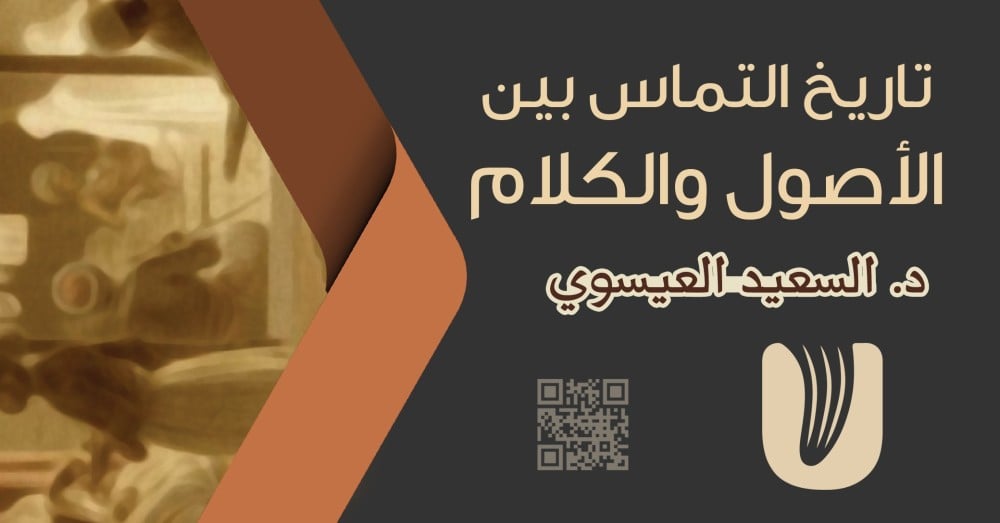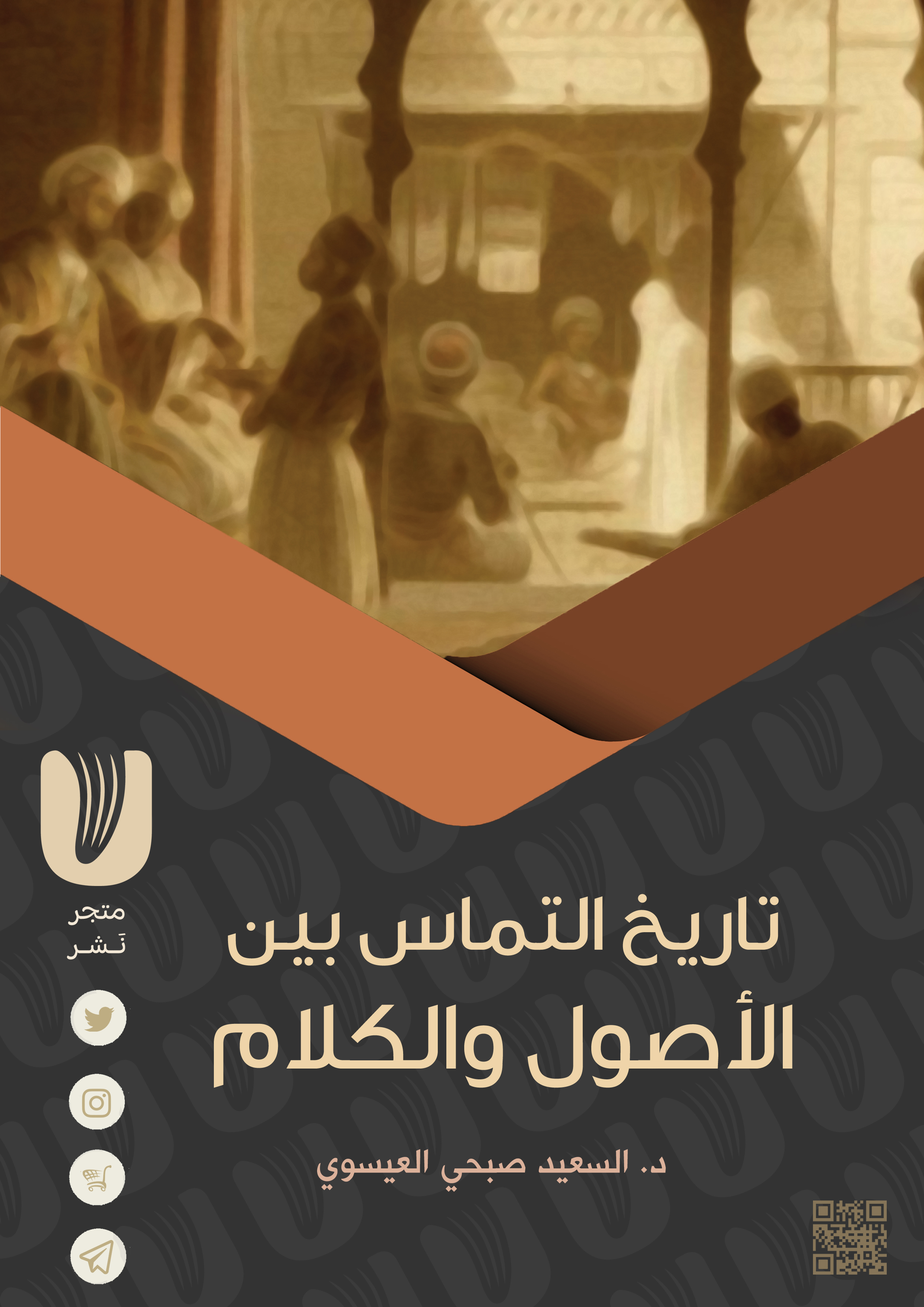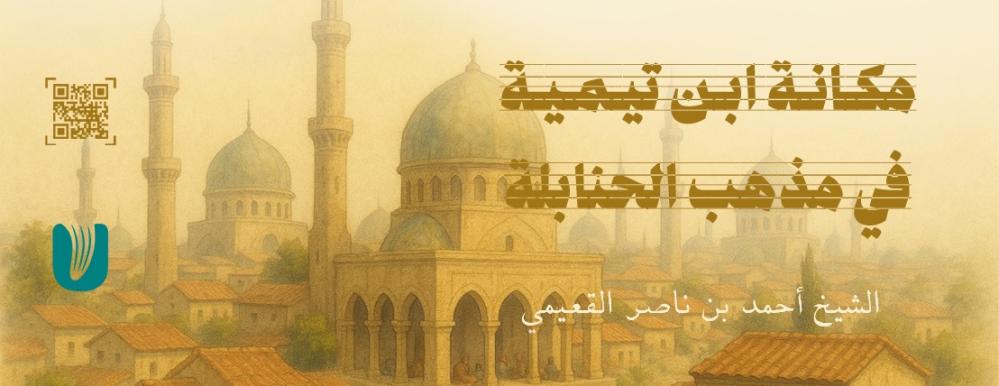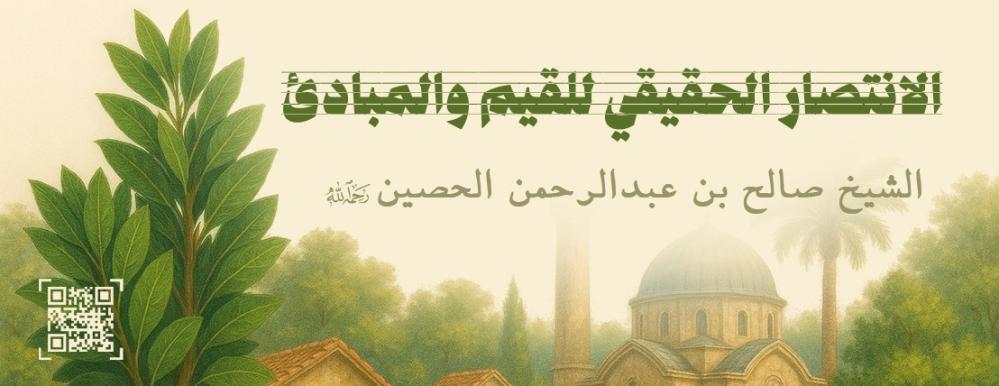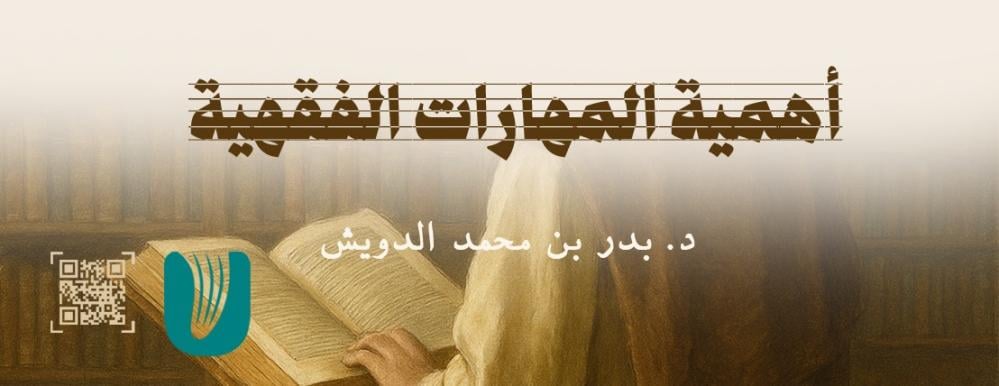History of contact between origins and speech
Dr.. Al-Saeed Subhi Al-Issawi
The beginnings of the first writings on the science of jurisprudence began, carrying within them a message emphasizing the role of the science of jurisprudence as a science serving jurisprudence and other topics that help in deduction and inference.
Due to this service nature in the jurist’s promotion to the ranks of ijtihad, he remained far from verbal discussions, and it was not known in the sources of the early principles of mixing between them, and this is very clear from Imam Al-Shafi’i in “Al-Risala.”
The first beginnings of contact between the two sciences appeared gradually in the third century AH, then intensified in the fourth century, until at the end of it, fundamentalist Mu'tazili and Ash'arite writings appeared, mixing the science of jurisprudence and the science of theology, and were the starting point for tightening the connection between the two sciences in most of the fundamentalist books that were written down in the centuries. loyal, which has witnessed a more noticeable increase over time ( [1] ) .
The fourth century AH was barely halfway through when Judge Abd al-Jabbar al-Mu'tazili ( [2] ), who died at the beginning of the fifth century, emerged, after living much of it in the fourth century. He is the most famous Mu'tazili theologian who paid attention to the fundamentalist heritage of his predecessors by clarifying, protesting, criticizing, and adding, and he can be described as a theologian. A fundamentalist, and that is because he did not content himself with introducing theological issues into his fundamentalist books, but rather he included fundamentalist issues into his theological books, and among his most important books are “Al-Nihayah,” “Al-Umd,” and “Sharh Al-Umd.” Although these books have not reached us, the book “Al-Mu’tamid,” which Explanation of Abu Al-Hussein Al-Basri The book “Al-Amad” is clear evidence of the introduction of theology into the science of jurisprudence.
As for his mention of fundamental issues in his theological writings, they appear clearly in his book “Al-Mughni fi Chapters on Justice and Tawhid.” In addition to the various fundamental issues he mentioned in the rest of the parts, as in Part Sixteen in particular, he devoted the entire Seventeen Part to discussion of “Sharia.” This part was a fundamentalist book in which the two fundamentals meet. The origin of belief, and the origin of action. In this part, Judge Abdul-Jabbar paid attention to detailing many issues that fundamentalists sometimes neglected, or expressed in a general way about them. His other books are hardly devoid of fundamentalist issues, even incidentally, or by way of evidence, such as the book “Explanation of the Five Fundamental Principles” - assuming that its attribution to him is proven -, and in fact his book “Al-Muhit fi Al-Takleef” is concerned with a topic that is considered one of the most important topics in common among scholars. Speech and origins. We can consider Al-Qadi’s writings to be among the most important sources that preserve the opinions of the fundamentalist Mu’tazilites and their reasoning ( [3] ) .
As for the next step, it was the reaction of the Ash'aris and Maturids to criticize the Mu'tazila views spread in the sciences, including the science of jurisprudence, and a strong turning point occurred. The Ash'ari school replaced the Mu'tazila school, and dialectical discourse was replaced by another type of organized scientific debate ( [4] ) .
The Ash'arite idea took the form of rational opposition to the Mu'tazila idea, which had a significant impact in raising the Mu'tazilites' level of proofs and arguments. This is because behind this new school were people who had experienced the Mu'tazila, recognized its shortcomings and shortcomings, and realized the shortcomings in Mu'tazilites' thinking and their approaches. Which means the ability of this school and its symbols to oppose the ideas and opinions of the Mu’tazilites, based on the same approach that they adopt in defeating their opponents ( [5] ) .
This stage witnessed the emergence of Judge Abu Bakr Al-Baqalani. He played a major role in fundamentalist writing and discussion of the Mu’tazilites in what they stated in a more simplified form. He was distinguished by his abundance of classifications and writings. He was the subject of the attention and attention of many fundamentalists and theologians who came after him. If Al-Shafi’i had introduced the science of jurisprudence in the stage of codification, then Al-Baqalani had moved the jurisprudential writing to the stage of comprehensive expansion, and to the expansion of mingling with the science of theology ( [6] ) , or as some described it, “he drowned the fundamentals of jurisprudence in the sea of speech, Until those after him had no choice but to follow him” ( [7] ) .
Imam Al-Zarkashi dates this period and says: “Those came after him [i.e., after Al-Shafi’i, may God have mercy on him], and they clarified, clarified, expanded, and explained, until two judges came: the Sunni judge Abu Bakr Ibn al-Tayyib and the Mu’tazila judge Abdul Jabbar. They expanded the expressions, unpacked the references, clarified the generality, and removed the ambiguities. And the people followed in their footsteps, and walked on the love of their fire, so they liberated, decided, corrected, and photographed” ( [8] ) .
What is noticeable among many of those who chronicled the relationship between the two sciences is that history neglects the approach of the Sunnis and the community and their role in criticizing the Mu’tazila and Ash’ari opinions. Among these imams who had a major role in criticizing the theological schools and their contributions to the science of fundamentals is Imam Abu Al-Muzaffar - may God have mercy on him - and perhaps this is the study that demonstrated We have proof of his role in criticizing the theological influence in the science of etymology.
This was followed by the emergence of fundamentalist writings in which there was a lot of overlap between the two sciences, and each one championed his doctrine and belief, such as the books of Abu al-Ma’ali al-Juwayni ( [9] ) , Abu Hamid al-Ghazali ( [10] ) , al-Amidi ( [11] ) , and Abu al-Khattab al-Kaludhani ( [12] ). And Ibn Qudamah ( [13] ) , and Ibn Taymiyyah - may God Almighty have mercy on them. The books of fundamentals were not immune from the consequences of verbal interference, the prevalence of controversy, the splitting of differences and objections, and the like.
As for the effect of this overlap in the science of fundamentals, the later ones “precluded what was broad, excluded what was vast, limited themselves to some of the main issues, multiplied similarities and evidence, limited themselves to transmitting the doctrines of the opposing sects, and abandoned the sayings of those who have a basis for this art, and to its reality.” He arrived, and his matter almost went back to the beginning, and the joy of relying on him went away, so they say: In contrast to Abu Hashim ( [14] ) , or in accordance with Al-Jabbai ( [15] ) , and it is for Al-Shafi’i, and it is stated among his companions about taking care of it specifically, and they have passed away from the words of the predecessors, with elegant expressions and reports. Excellent, and we say strange, and strange investigations” ( [16] ) .
In short, since the fourth century AH, theologians have mastered the science of jurisprudence, and their method in it has prevailed over the method of jurists, so the effects of philosophy and logic have penetrated into it, and it has been closely connected with them, until it has become as if it is the dominant feature in the writings of the fundamentalists ( [17] ) .
This was written by one of the notables of the fifth century, Abu al-Muzaffar. He says: “The dialectics prevailed greatly, and they were convinced of the opponents’ defense, and were satisfied with embellished expressions that were superior to what was needed” ( [18] ) .
Barely had the fifth century AH begun before the two sciences were mixed. The science of jurisprudence and theology, and the ideas of jurisprudence are filled with introductions and topics from the science of theology. Everyone starts from his own belief and approach, and decides what he accepts as a doctrine and what God condemns.
___________________________________________
([1]) See: Flossi, The School of Theologians and Its Methodology in Studying the Fundamentals of Jurisprudence , 1st ed., p. 304, and Al-Shutaiwi, The Relationship of the Science of the Fundamentals of Jurisprudence to the Science of Theology, 1st ed., pp. 106-107.
([2]) He is Abd al-Jabbar al-Hamdhani al-Asadabadi, the Mu’tazilite al-Shafi’i. His: Al-Mughni in the chapters on monotheism and justice, and the classes of the Mu’tazila. He died in Al-Rai in the year 415 AH. See: Al-Subki, Tabaqat Al-Shafi’iyyah Al-Kubra 5/97, and Kahhala, Dictionary of Authors , ed. 5/78.
([3]) Khathiri, The Fundamentalist Thought of the Mu’tazilites, 1st edition, p. 166, and Al-Shutaiwi, The relationship of the science of jurisprudence to the science of theology, p. 108.
([4]) See as an example: Al-Maturidi, Al-Tawhid , ed., pp. 151-152, and Ibn Fork, Articles of Sheikh Abi Al-Hasan Al-Ash’ari , 1st ed., p. 128, and Madkour, The Aristotelian Method and Theological and Jurisprudential Sciences , (part translated from French), ed. pp. 164-165.
([5]) See: Sano, Epistemological Readings in Fundamentalist Thought, 1st ed., pp. 90-91.
([6]) See: Al-Raysuni, The Theory of Objectives according to Imam Al-Shatibi, pp. 45-46.
([7]) See: Al-Arousi, Common Issues between the Principles of Jurisprudence and the Principles of Religion, pp. 12-16, and Al-Harithi, The Relationship of the Principles of Jurisprudence to the Science of Logic, ed. 1, p. 133.
([8]) Al-Zarkashi, Al-Bahr Al-Muhit 1/25-26.
([9]) He is Abdul Malik bin Abdullah bin Yusuf Al-Juwayni, Al-Shafi’i Al-Ash’ari. He has: Al-Burhan, Al-Waraqat, and Nihayat Al-Muttalib. He died in Nisapur in the year 478 AH. See Al-Subki, Tabaqat al-Shafi’iyyah al-Kubra , 5/165, and Ibn Kathir, Tabaqat al-Shafi’i Jurists , ed. 2/466.
([10]) He is Muhammad bin Muhammad bin Muhammad Al-Ghazali, Abu Hamid, Al-Shafi’i, an Ash’ari theologian. He has: Al-Mustafa, Al-Ihya’, and Al-Mankhul. He died in the year 505 AH. See: Al-Safadi, Al-Wafi bi Al-Wafiyat, 1/211, Al-Dhahabi, Siyar A’lam Al-Nubala’ , 19/323, and Al-Zirakli, Al-A’lam 7/23.
([11]) He is Ali bin Abi Ali, Abu Al-Hasan Saif Al-Din Al-Amidi, Al-Ash’ari. He has: Early Thoughts, and Al-Ahkam fi Usul Al-Ahkam. He died in Damascus in the year 631 AH. See: Al-Subki, Tabaqat Al-Shafi’iyyah Al-Kubra 8/306, and Al-Safadi, Al-Wafi bi Al-Wafiyat 21/225.
([12]) He is Mahfouz bin Ahmed Al-Kaludhani, Abu Al-Khattab, Al-Hanbali. It includes: refinement in the obligatory duties, and introduction to the principles. He died in 510 AH. See: Ibn Muflih, Al-Maqsad Al-Arshad , 1st ed. 3/20, Al-Dhahabi, Siyar A’lam Al-Nubala ’ 19/348, and Al-Zirakli, Al-A’lam 5/291.
([13]) He is Abdullah bin Ahmed bin Qudamah Al-Jumaili, Al-Maqdisi, Al-Hanbali, Abu Muhammad Muwaffaq Al-Din. His: Al-Mughni, Al-Kafi, and Rawdat Al-Nazir. He died in the year 620 AH. See: Al-Dhahabi, Siyar A`lam al-Nubala’ , 22/166-173, and Al-Safadi, Al-Wafi bi’l-Wafiyat , 17/23.
([14]) He is Abd al-Salam bin Muhammad bin Abd al-Wahhab al-Jabbai al-Mu’tazili. He has: al-Jami’ al-Kabir and al-Ardh. He died in Baghdad in the year 321 AH. See: Al-Baghdadi, Tarikh Baghdad , 1st edition 11/56, Al-Dhahabi, Siyar Alam Al-Nubala ’ 15/63-64, and Al-Safadi, Al-Wafi bi’l-Wafiyat 4/55.
([15]) He is Muhammad ibn Abd al-Wahhab, Abu Ali al-Jabba’i al-Mu’tazili. He wrote: Principles, Forbidding of Vice, and the Response to Ibn Kilab. He died in 303 AH. See: Al-Dhahabi, Al-Sir 14/183, Al-Safadi, Al-Wafi bi’l-Wafiyat 4/55, and Al-Zirakli, Al-A’lam 6/256.
([16]) See: Al-Zarkashi, Al-Bahr Al-Muhit 1/26.
([17]) See: Abd al-Razzaq, An Introduction to the History of Islamic Philosophy, ed., p. 364, and Ali, Series on the Purification of Fundamentals of Interest, p. 85.
([18]) Al-Sam’ani, Al-Qawati’ 3/1017-1018.
Click here to access the full book page.
Click on the image to access the image version (pdf), which can be downloaded and published.

